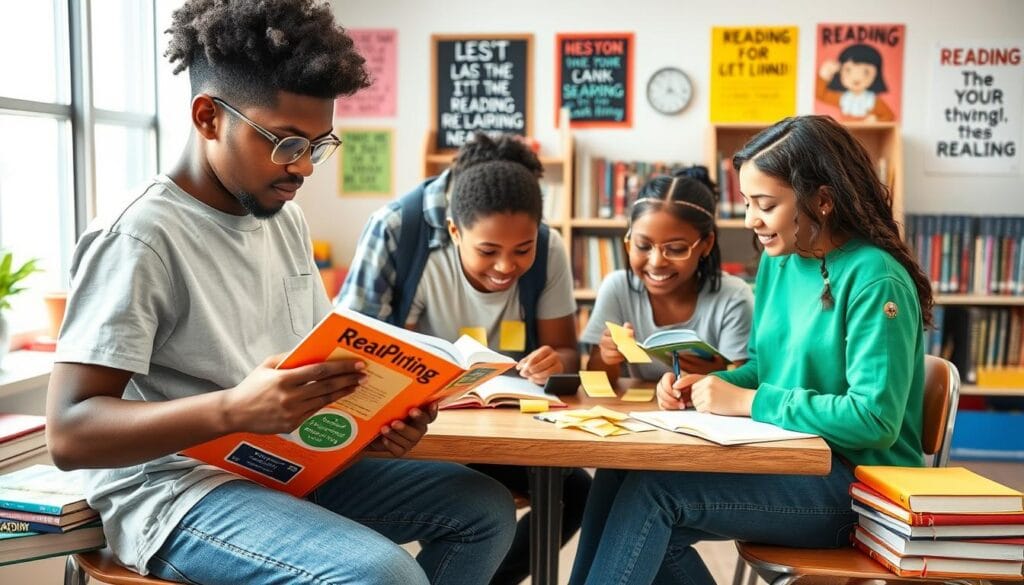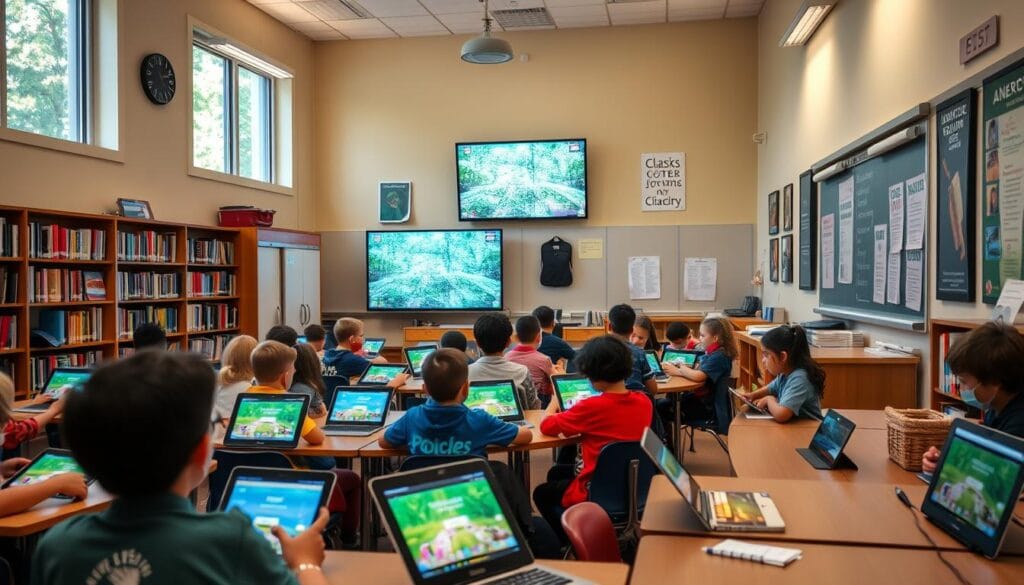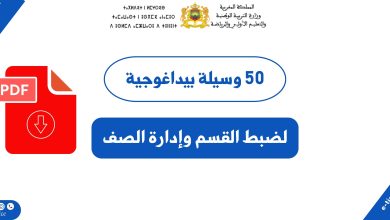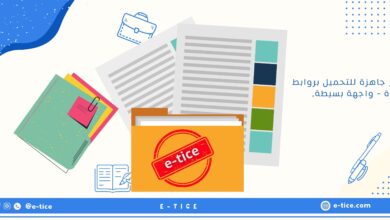8 Effective Reading comprehension Strategies for Middle School
When students move to middle school, they face new challenges in reading. They need to understand and remember complex texts better. Reading is more than just reading words; it’s about getting the meaning, making smart guesses, and thinking critically.
In this article, we’ll look at ways and tools to help middle school students read well. These strategies will make them confident and ready for future learning and personal growth.
فهرس المقالة
Understanding the Foundations of Reading Comprehension in Middle School
Reading comprehension is key for middle school students. They face more complex texts in various subjects. It’s vital to grasp the basics of reading, how our brains process text, and the milestones in reading growth.
Key Components of Reading Development
Good reading skills start with phonemic awareness, phonics, fluency, vocabulary, and comprehension. Middle schoolers need to master these to understand what they read.
The Role of Cognitive Processing in Understanding Text
Reading is a complex mental task. It involves attention, memory, making inferences, and critical thinking. As they grow, students should learn to engage with texts, make connections, and think deeply about what they read.
Developmental Milestones in Reading Proficiency
Students in middle school should show they can identify main ideas, make inferences, and analyze text. They should also be able to combine information from different sources. Keeping an eye on these milestones helps teachers and parents support students better.
| Reading Comprehension Skill | Developmental Milestone (Grade 6-8) |
|---|---|
| Main Idea Identification | Able to accurately identify the central theme or key points in a passage |
| Drawing Inferences | Demonstrating the ability to make logical inferences based on evidence in the text |
| Text Structure Analysis | Recognizing and understanding different text structures, such as chronology, cause-effect, and compare-contrast |
| Information Synthesis | Integrating and synthesizing information from multiple sources to gain a comprehensive understanding |
Knowing the basics of reading comprehension helps teachers and parents support middle school students. This support is crucial for their academic success.
Essential Reading Comprehension Strategies for Middle School Success
As a middle school student, it’s key to learn reading comprehension strategies for success. These skills help you dive into texts, understand better, and keep information. By getting good at these techniques, you’ll read with confidence and skill.
Active reading is a crucial strategy. It means you’re fully involved with the text. This includes:
- Previewing the text to get context and set goals
- Asking questions before, during, and after to get deeper
- Writing notes, highlighting important parts, and linking ideas
- Summarizing the main points to make sure you get it
Text analysis skills are also vital. They help you understand the text’s structure, organization, and purpose. This includes:
- Spotting different text types (like stories, facts, or opinions)
- Finding the author’s tone, view, and message
- Using evidence from the text to make guesses and conclusions
Using these reading comprehension strategies and text analysis skills will help you tackle tough texts. You’ll understand more, and do better in school.
| Reading Comprehension Strategy | Description |
|---|---|
| Previewing | Looking at the title, headings, images, and other visual cues to get a quick idea of the text before diving in. |
| Questioning | Asking questions before, during, and after reading to get a deeper understanding and find important details. |
| Annotating | Writing notes, highlighting key points, and connecting ideas while reading to really engage with the text. |
| Summarizing | Restating the main points, themes, and key takeaways in your own words to make sure you understand. |
“Effective reading comprehension is not just about understanding the words on the page, but actively engaging with the text to construct meaning and deepen your understanding.”
Active Reading Techniques to Enhance Text Understanding
Learning active reading techniques can change the game for middle school students. It helps them understand and engage with texts better. By being more active in their reading, students can grasp and remember important details more effectively.
Pre-reading Preparation Methods
Before starting a text, students should do some prep work. This includes skimming the content, finding key headings, and using what they already know about the topic. These steps help students get ready and focus better while reading.
During-reading Engagement Practices
While reading, students should stay involved. They can take notes, highlight important parts, and pause to summarize. Asking questions and connecting what they read to their own life also helps. This keeps them from just reading passively.
Post-reading Reflection Activities

- After finishing a text, students should reflect on what they learned. They can make mind maps or timelines to organize their thoughts.
- Discussing with others or writing down their thoughts helps solidify what they’ve read. It also brings up any questions or areas they need to explore more.
By using these active reading methods before, during, and after reading, middle school students can connect with texts on a deeper level. This leads to better understanding and success in school.
| Active Reading Technique | Benefits |
|---|---|
| Previewing the text | Helps students activate prior knowledge and anticipate content |
| Taking notes and highlighting | Promotes active engagement and facilitates information retention |
| Asking questions | Encourages critical thinking and deeper understanding |
| Post-reading reflection | Allows students to synthesize information and identify areas for further study |
“The key to successful reading comprehension is not passive absorption, but active engagement with the text.”
Building Strong Vocabulary Skills for Better Comprehension
Building a strong vocabulary is key to better reading skills. It helps you understand texts better, make deeper connections, and enjoy reading more. Here are some top ways to boost your vocabulary and reading skills.
Leverage Context Clues
Using context clues is a smart way to learn new words. Look at the words around the unknown term to figure out its meaning. This makes you a more active and smart reader.
Discover Word Roots
Knowing where words come from can really help. Learn about common prefixes, suffixes, and roots from languages like Greek and Latin. This helps you understand many complex words and improves your word recognition.
Engage in Systematic Vocabulary Instruction
Make learning new words a regular part of your routine. Use tools like vocabulary workbooks, flashcards, or online apps. Regular practice with these tools can greatly improve your reading skills.
| Vocabulary Building Method | Key Benefits |
|---|---|
| Context Clues | Develops word analysis skills, improves comprehension of unfamiliar terms |
| Word Roots | Enhances word recognition, facilitates understanding of complex vocabulary |
| Systematic Vocabulary Instruction | Builds long-term word knowledge, supports overall reading proficiency |
By using these methods, you can unlock the power of words. This will take your reading skills to new levels. Start building your vocabulary today and become a more confident reader.
Critical Thinking and Analysis Tools for Complex Texts

Dealing with complex texts can be tough for middle school students. But, with the right tools, they can dive deeper into the material. We’ll look at techniques to help your child improve their text analysis skills and spot connections within and between texts.
Text Structure Analysis Methods
Getting the hang of a text’s structure is crucial for understanding it. Teach your child to spot the intro, body, and conclusion. Help them see how the author organizes their thoughts and the purpose behind it. This will help them remember more and make smart conclusions.
Making Logical Connections
Critical thinking means linking ideas together, both in one text and across different sources. Encourage your child to find connections like cause and effect or compare and contrast. Doing these critical thinking exercises will boost their text analysis skills and show them the logical connections in the content.
Evidence-Based Reasoning Techniques
It’s important for middle school students to back up their claims with evidence. Teach them to check the credibility of sources and tell fact from opinion. Encourage them to use specific text evidence to support their views and draw smart conclusions.
By learning these critical thinking and analysis tools, your middle school student will get better at handling complex texts. They’ll be able to find important insights and understand the material better. These skills will help them in school and beyond.
| Technique | Description | Benefits |
|---|---|---|
| Text Structure Analysis | Identifying the main elements and organizational patterns of a text | Enhances comprehension, retention, and ability to draw conclusions |
| Making Logical Connections | Analyzing relationships between ideas, both within and across texts | Strengthens text analysis skills and the ability to see logical connections |
| Evidence-Based Reasoning | Supporting claims with credible textual evidence and distinguishing fact from opinion | Develops critical thinking and the ability to draw well-reasoned conclusions |
Integrating Technology and Digital Resources for Reading Practice
Technology is changing how middle school teachers teach reading. They use digital tools to make reading fun and interactive. This helps students get better at reading and become more confident.
There are many digital tools for reading practice. Students can use e-books, virtual reading spaces, and apps. These tools make learning exciting and help students improve their reading skills.
Digital reading platforms are popular in schools. They offer texts for different ages and include activities to help students understand what they read. These platforms also give feedback and track progress, making learning personal.
Educational apps and websites make reading fun with games and quizzes. They help students practice reading and learn new words. These tools make learning fun and engaging.
Teachers use virtual collaboration tools to help students talk about what they read. This builds a sense of community and improves critical thinking. It’s a great way to learn together.
By using technology, middle schools create exciting learning spaces. These spaces meet the needs of all students. They help students not only read better but also prepare for the digital world.
| Digital Resource | Description | Benefits |
|---|---|---|
| Interactive e-books | Digital books with multimedia, activities, and personalized features | Enhances engagement, supports learning styles, and gives feedback |
| Educational reading apps | Apps for reading, vocabulary, and comprehension | Fun, gamified reading practice, accessible anytime |
| Virtual collaboration tools | Online platforms for discussing and sharing about texts | Improves critical thinking, communication, and community |

Technology and digital tools make learning exciting for middle school students. They help students improve their reading skills and prepare for the digital world. This approach supports their academic and personal growth.
Developing Metacognitive Strategies for Deep Understanding
As you aim to become a better reader, it’s key to develop metacognitive strategies. These are the skills to think about how you think. They help you understand texts better and reach your full reading potential.
Self-monitoring Techniques
Self-monitoring is a vital skill. It means checking your understanding as you read. You pause to think about what you get and what’s still unclear.
By doing this, you can spot where you need to slow down or get more help.
Comprehension Check Methods
Comprehension check methods are also important. They offer ways to see if you really get the text. You might summarize key points, ask questions, or make diagrams.
These methods keep you engaged and help you process the information better.
Reading Goal Setting
Setting reading goals is another great tool. Having clear goals, like understanding main ideas or seeing connections, helps you stay focused. Reflecting on your progress boosts your awareness.
Using these strategies, you can control your reading and become a more aware learner. Start using these methods and discover deep understanding in your middle school studies.
Supporting Struggling Readers with Targeted Interventions
Middle school can be tough for students who find reading hard. Teachers need to spot these students and help them. With the right strategies and tools, students can get better at reading and do well in school.
Helping each student in their own way is key. Teachers should check what each student needs and make plans just for them. This might mean lessons on reading sounds, words, or how to understand texts better.
- Teach important reading skills like decoding and fluency.
- Use proven programs to boost reading skills.
- Offer one-on-one or small-group tutoring for extra help.
Using technology can also help. Digital tools, apps, and audiobooks make learning fun and fit different learning styles.
| Intervention Strategies | Resources |
|---|---|
| Phonics-based instruction | Leveled reading programs |
| Vocabulary development | Audiobook libraries |
| Comprehension strategy training | Interactive reading apps |
By mixing different help methods and using tech, students can improve. Every student can become a confident and skilled reader with the right help.
“The greatest gift we can give our students is the power of reading. When we help a struggling reader, we unlock a world of possibilities.”
Adaptive Teaching Methods for Different Learning Styles
In middle school classrooms, students do best when teaching meets their learning styles. Using adaptive teaching methods helps teachers bring out the best in their students. This ensures learning is meaningful and effective.
Visual Learning Strategies
Visual learners love using diagrams, charts, and multimedia. These tools help them grasp complex ideas better. Mind maps, timelines, and infographics spark their curiosity and improve retention.
Auditory Learning Techniques
Auditory learners benefit from sound. Audio recordings, class talks, and read-alouds boost their understanding. Teachers can engage these students through their strong listening skills.
Kinesthetic Reading Activities
Kinesthetic learners enjoy hands-on activities. Creating dioramas, role-playing, or digital simulations excites them. These activities tap into their love for movement and touch, deepening their connection to the material.
Teaching to the learning styles of middle school students is crucial. It empowers them to excel in reading. By meeting the needs of visual, auditory, and kinesthetic learners, teachers create a vibrant learning space. This environment fosters success in academics.
| Learning Style | Adaptive Teaching Methods |
|---|---|
| Visual | Diagrams, charts, multimedia presentations, mind mapping, interactive timelines, infographics |
| Auditory | Audio recordings, class discussions, read-alouds |
| Kinesthetic | Hands-on reading activities, dioramas, role-playing, interactive digital simulations |
Conclusion
Effective reading comprehension strategies are key for middle school students’ success. They help in developing lifelong learning skills. By understanding reading development, mastering comprehension techniques, and using technology, you can help your students.
Reading comprehension is more than just reading words. It’s about making meaning, connecting ideas, and understanding deeply. By using the strategies from this article, your students will not only do well in school. They will also develop a love for learning that lasts a lifetime.
Teaching middle school students to read well is an investment in their future. It prepares them for success in school, personal projects, and life. By using these strategies, your students will become confident, critical thinkers ready for whatever comes next.
FAQ
What are the key components of reading development in middle school?
Reading development in middle school includes phonemic awareness, fluency, vocabulary, and comprehension. These elements help students become proficient readers.
How can I engage my middle school student in active reading techniques?
Engage your student with pre-reading preparation, like previewing the text and setting goals. Use during-reading activities like annotating and questioning. Post-reading reflection, such as summarizing and making connections, is also key.
Why is vocabulary development important for reading comprehension?
A strong vocabulary is essential for reading comprehension. It lets students understand words in a text. Use context clues, learn word roots, and teach vocabulary systematically to help your student.
How can I help my middle school student develop critical thinking and analysis skills for complex texts?
Teach your student to analyze complex texts by learning about text structure and making connections. Use evidence-based reasoning to deepen their understanding of challenging texts.
What are some metacognitive strategies that can improve reading comprehension?
Improve reading comprehension with self-monitoring, comprehension checks, and setting reading goals. These strategies enhance awareness of thinking processes and text understanding.
How can I support a struggling reader in middle school?
Support a struggling reader with targeted interventions like one-on-one instruction and small group work. Use assistive technology and identify specific challenges to tailor support effectively.
What are some adaptive teaching methods that cater to different learning styles in middle school?
Use visual, auditory, and kinesthetic strategies to meet diverse learning styles. Graphic organizers, multimedia, read-alouds, discussions, and hands-on projects are effective. This approach accommodates different learning styles.


